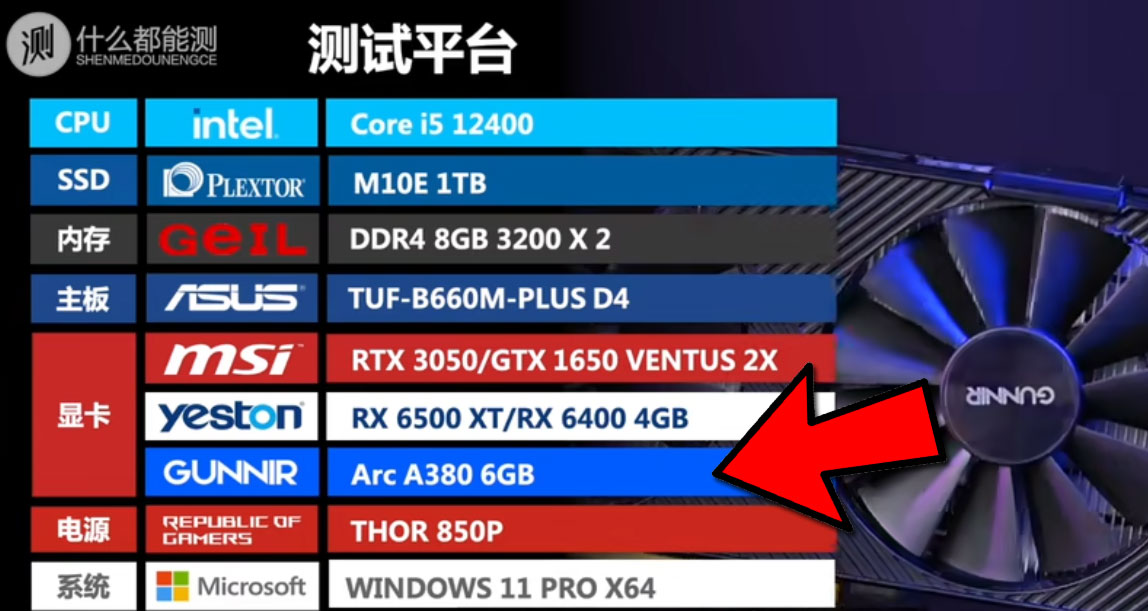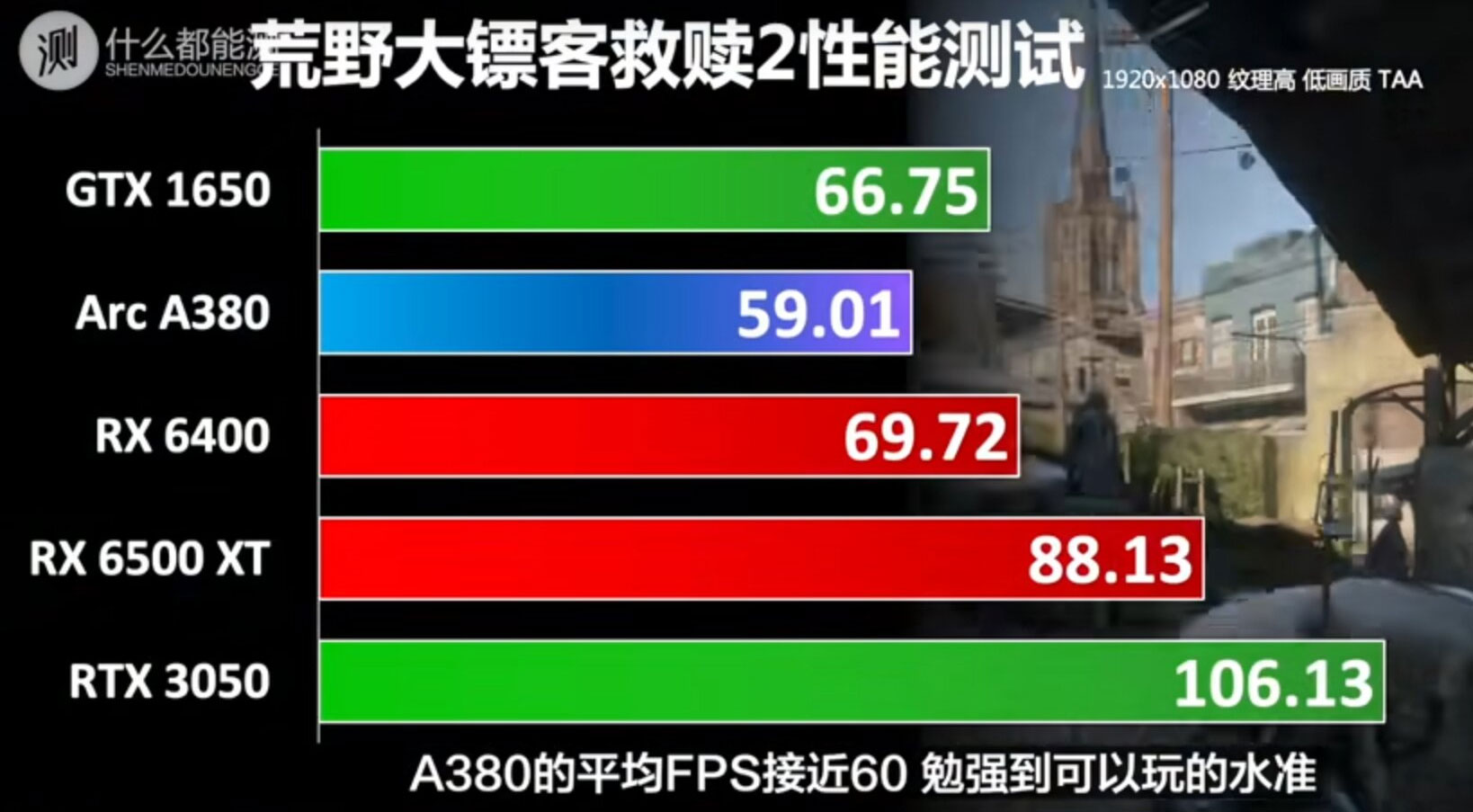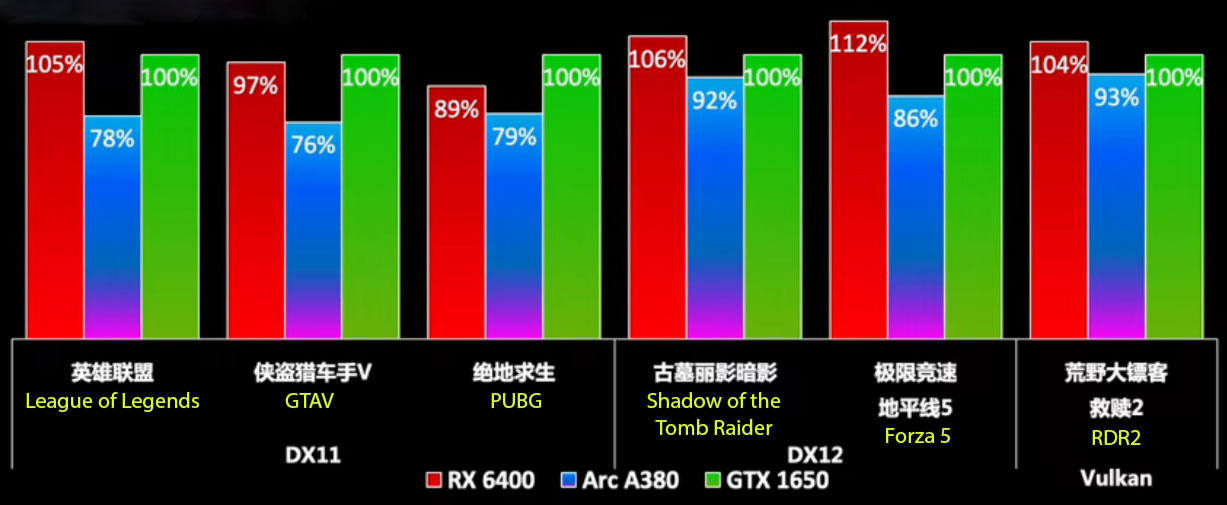Intel Arc A380 Slower Than GTX 1650, RX 6400 in Gaming Tests
It does better in 3DMark benchmarks, but that's little consolation
Last week, Intel launched the Arc A380, with products initially available in China only. Today, several Chinese sites and social media users published their independent third-party reviews. We've taken a closer look at a video review published by Bilibili user Shenmedounengce to see if there is any insight to share before we can get our own A380 in the Tom's Hardware labs. In brief, Intel's first Arc Alchemist desktop GPU likely won't displace the best graphics cards, and it did much better in synthetic benchmarks than the suite of games tested.
The Bilibili user's test platform was relatively modest, which is a fair choice given the target market of the Arc A380. It's a Windows 11 PC based around an Intel Core i5-12400, 16GB of RAM, 1TB SSD, and an Asus B660M motherboard, which should be ample for supporting the likes of the new Arc A380. The Gunnir branded model was used, which appears to be the first one to be released. Intel's new hope was pitted against the following contenders in the same system: a GTX 1650, RX 6400, RX 6500 XT, and RTX 3050.
In synthetic tests, the Intel Arc A380 was fairly impressive, beating out all rivals except the RTX 3050 in Time Spy and Port Royal, but falling back a bit to best just the GTX 1650 in Fire Strike. Unfortunately, this marked the end of the good news for those hoping for an impressive Intel Arc debut.
In the six games tested at 1080p (League of Legends, GTA V, PUGB, Shadow of the Tomb Raider, Forza Horizon 5, and Red Dead Redemption 2), Intel's Arc A380 was consistently the poorest performer. Above, we have shared a video screenshot of the detailed Red Dead Redemption 2 performance comparison. This is a fairly typical bar chart across all the games.
There's also a summary chart with all six games, though that omits the much better performance offered by the RX 6500 XT and RTX 3050.
With the performance comparisons above, it is worth looking at the differences in the underlying technologies.
| Header Cell - Column 0 |
Arc A380 |
Radeon RX 6400 |
GeForce GTX 1650 |
|---|---|---|---|
| Node |
TSMC N6 |
TSMC N6 | TSMC 12nm |
| Architecture |
Alchemist |
RDNA 2 |
Turing |
| GPU |
DG2-128EU |
Navi 24 |
TU117 |
| Graphics cores |
1,024 |
768 |
896 |
| FP32 TFLOPS |
5.02 |
3.57 |
2.90 |
| Memory | 6GB GDDR6 96-bit 15.5Gbps, 192 GB/s | 4GB GDDR6 64-bit 16Gbps. 144 GB/s | 4GB GDDR5 128-bit 8Gbps, 128 GB/s |
| TDP/TBP |
75 Watt |
53 Watt |
75 Watt |
| Video Codecs | AV1, H.264, H.265 decode/encode | H.264, H.265 decode only | H.264, H.265 decode/encode |
| Approx Price |
$135 |
$159 | $190 |
Pricing of the Intel Arc A380 in China suggests US retailers will advertise these models at around $135, as we explained last week. At the moment, that would help Intel undercut its rivals in the above table for its lower gaming performance, which seems appropriate. However, with the Intel GPUs having better performance in 3DMark benchmarks and decent-looking stats, it's natural to wonder whether Intel's drivers could improve to provide significant uplifts in actual gaming.
We're looking forward to getting an Intel Arc A380 desktop graphics card for our own extensive tests. However, according to these early results, it doesn't look like Intel will rank too highly in our GPU benchmarks hierarchy, unless drivers improve a lot in the coming months.
Get Tom's Hardware's best news and in-depth reviews, straight to your inbox.

Mark Tyson is a news editor at Tom's Hardware. He enjoys covering the full breadth of PC tech; from business and semiconductor design to products approaching the edge of reason.
-
-Fran- Since AMD has the "fine wine" effect, what is Intel going to be? Fine beer? Fine vinegar? xDReply
Regards. -
hannibal Fine existance…Reply
This is intels first attemp for years. It will Take a couple of years to catch NVIDIA and AMD. Do the Intel have endurance to struckle that long and after that. Thats is the most interesting question in this. Previous times Intel has given up quite soon. -
King_V Oof... 75W, with the same TSMC N6 node that the 54W AMD card has, and underperforms both the 75W GTX 1650 and the 54W RX6400? Not a good look.Reply
Presumably they will offer a "doesn't require a PCIe 6-pin" model. One would think.
If this succeeds, it will ONLY succeed on price. Even then, it mostly loses out to the RX 6400 on the price/performance metric. And, rated at 75W, are there going to be any single-slot low-profile variants possible? I'm thinking not.
Not so sure about the 1650, which seems to be stubbornly staying mostly in the $200+ range, but I imagine that the RX 6400's price will come down some. Intel is going to have to price things more aggressively to sell this. -
-Fran- In fairness to Intel, this is most likely a driver gap (hence my comment) that can be worked on with time. I mean, this is completely within my expectations and, I hope, of any rational human being. Only the savage monkeys are rattling the cage at the sight of lower numbers for the first round of cards. It's not ideal, but hardly surprising, in short.Reply
The OEMs bit is going to be interesting to see. How Intel is going to... Heh... Let's say "entice" the OEMs to use these cards in their initial under-performing and under-whelming batch. I'm sure nVidia is staring at OEMs quite hard; even more so than AMD. I'm sure they don't want to be Athlon'ed with the OEMs.
Regards. -
ingtar33 intel has 2 decades of track record of some of the worst graphical driver support in the industry. until ARC proves it has functioning and stable drivers with regular updates this will be a hard pass for me.Reply -
Roland Of Gilead I don't know. I mean, I don't think it's that bad of a first try. There are a couple of good things going for it. 6gb of Vram, low pricing compared to the other GPU's. The price offset is relative to the drop in performance.Reply
Okay, you could argue the 6gb of vram is not worth much at that level card. But still. Don't forget though, these are just entry level cards. The A5xx and A7xx are more midrange to higher end. Will be interesting to see their performance numbers.
It seems clear Intel are piling on the vram for each level card though as a way to attract the less knowledgeable purchasers.
I would totally agree on the drivers being key to the success or not of Intel GPU's. They have been massively lacking in terms of their iGPU's, so we can only hope they step up.
With Raja Koduri at the helm, I expect the driver issue will be short lived, and improved upon in major ways, so as to compete better with AMD/Nvidia. -
KyaraM I'm actually rather impressed. This isn't a bad start at all and the synthetic test give reason for hope as well. Hopefully we will see driver and thus peeformance improvements soon. But all in all, this isn't a horrible start and prices are pretty competitive, too, which can only help them.Reply -
Eximo Yeah, DX12 and Vulcan are looking alright. Focusing on more recent technology makes some sense. The DX11 back catalog can wait. They'll want their big card to perform well in recent titles.Reply -
TerryLaze Reply
The OEM specific dg1 was released over a year ago, and since we didn't have tons of clickbait articles saying how badly they did we can only assume that they did ok sales wise.-Fran- said:The OEMs bit is going to be interesting to see. How Intel is going to... Heh... Let's say "entice" the OEMs to use these cards in their initial under-performing and under-whelming batch. I'm sure nVidia is staring at OEMs quite hard; even more so than AMD. I'm sure they don't want to be Athlon'ed with the OEMs.
Regards.
https://www.techpowerup.com/282385/intel-iris-xe-first-discrete-gpu-dg1-goes-on-sale-with-cyberpowerpc-gaming-systemhttps://www.tomshardware.com/news/intel-iris-xe-dg1-budget-1080p-gaming-gpu -
-Fran- Reply
It would be interesting to see sales numbers though.TerryLaze said:The OEM specific dg1 was released over a year ago, and since we didn't have tons of clickbait articles saying how badly they did we can only assume that they did ok sales wise.
https://www.techpowerup.com/282385/intel-iris-xe-first-discrete-gpu-dg1-goes-on-sale-with-cyberpowerpc-gaming-systemhttps://www.tomshardware.com/news/intel-iris-xe-dg1-budget-1080p-gaming-gpu
Plus, DG1 is not part of the ARC family and no one took DG1 as a proper "gaming" card. More like a test bed of sorts.
Regards.


